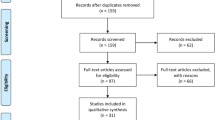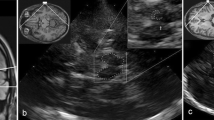Abstract
Transcranial sonography (TCS) shows an increased echogenic area of the substantia nigra (SN) in patients with Parkinson disease (PD). It has been increasingly used in the diagnosis of PD and its differentiation from atypical parkinsonian syndromes. Here, we studied the diagnostic accuracy of SN TCS in Italian patients. In this blinded cross-sectional study (NOBIS study), two expert neuro-sonologists performed TCS in 25 PD patients and 29 age- and sex-matched controls. The study participants were completely hidden to the TCS investigators using large drapery. One month later, the SN TCS recordings were re-read by the initial investigator, and cross-read by the second reader. Diagnostic accuracy was estimated on the first reading, intra-reader reliability on re-reading, and inter-reader reliability on cross-readings. The mean SN echogenic area was larger in the patients (0.24 cm2) than in the controls (0.15 cm2; Mann–Whitney test, p < 0.001). SN measures did not differ between right and left, or between ipsilateral and contralateral to the clinically more affected side. There was no correlation between SN echogenicity and PD severity or duration. High intra-reader (concordance correlation coefficient 0.93) and inter-reader (0.98) agreement of SN measurements was found. The diagnostic accuracy for the detection of PD was high (area under receiver-operating characteristic curve 0.91; 95% CI 0.83–1.00) with an optimum cut-off value for SN echogenic area of 0.18 cm2 with the device used here (specificity 0.83–0.90; sensitivity 0.72–0.92). This study supports the use of SN TCS in the diagnostic workup of PD if performed by trained readers.



Similar content being viewed by others
References
Alonso-Cánovas A, López-Sendón JL, Buisán J, de Felipe-Mimbrera Guillán M, García-Barragán N, Corral I, Matute-Lozano MC, Masjuan J, Martínez-Castrillo JC, Walter U (2014) Sonography for diagnosis of Parkinson disease-from theory to practice: a study on 300 participants. J Ultrasound Med 33(12):2069–2074
Altman DG, Bland JM (1983) Measurement in medicine: the analysis of method comparison studies. Statistician 32:307–317
Becker G, Seufert J, Bogdahn U, Reichmann H, Reiners K (1995) Degeneration of substantia nigra in chronic Parkinson’s disease visualized by transcranial color-coded real-time sonography. Neurology 45(1):182–184
Behnke S, Runkel A, Kassar HA, Ortmann M, Guidez D, Dillmann U, Fassbender K, Spiegel J (2013) Long-term course of substantia nigra hyperechogenicity in Parkinson’s disease. Mov Disord 28(4):455–459
Berardelli A, Wenning GK, Antonini A, Berg D, Bloem BR, Bonifati V, Brooks D, Burn DJ, Colosimo C, Fanciulli A, Ferreira J, Gasser T, Grandas F, Kanovsky P, Kostic V, Kulisevsky J, Oertel W, Poewe W, Reese JP, Relja M, Ruzicka E, Schrag A, Seppi K, Taba P, Vidailhet M (2013) EFNS/MDS-ES/ENS Recommendations for the diagnosis of Parkinson’s disease. Eur J Neurol 20(1):16–34
Berg D, Becker G, Zieler B et al (1999) Vulnerability of the nigrostriatal system as detected by transcranial ultrasound. Neurology 53:1026–1031
Berg D, Siefker C, Becker G (2001) Echogenicity of the substantia nigra in Parkinson’s disease and its relation to clinical findings. J Neurol 248(8):684–689
Berg D, Merz B, Reiners K, Naumann M, Becker G (2005) Five-year follow-up study of hyperechogenicity of the substantia nigra in Parkinson’s disease. Mov Disord 20(3):383–385
Berg D, Godau J, Walter U (2008) Transcranial sonography in movement disorders. Lancet Neurol 7(11):1044–1055
Bland JM, Altman DG (1986) Statistical methods for assessing agreement between two methods of clinical measurement. Lancet 1:307–310
Bouwmans AE, Vlaar AM, Mess WH, Kessels A, Weber WE (2013) Specificity and sensitivity of transcranial sonography of the substantia nigra in the diagnosis of Parkinson’s disease: prospective cohort study in 196 patients. BMJ Open 3(4):e002613
Bradvica IS, Mihaljević I, Butković-Soldo S, Kadojić D, Titlić M, Bradvica M, Kralik K (2015) Transcranial sonography and the pocket smell test in the differential diagnosis between Parkinson’s disease and essential tremor. Neurol Sci 36:1403–1410
Gaenslen A, Unmuth B, Godau J, Liepelt I, Di Santo A, Schweitzer KJ, Gasser T, Machulla HJ, Reimold M, Marek K, Berg D (2008) The specificity and sensitivity of transcranial ultrasound in the differential diagnosis of Parkinson’s disease: a prospective blinded study. Lancet Neurol 7(5):417–424
Gamer M, Lemon J, Singh P (2012) Various coefficients of interrater reliability and agreement. Package ‘irr’. https://CRAN.R-project.org/package=irr. Accessed 25 Apr 2017
Gibb WRG, Lees AJ (1988) The relevance of the Lewy body to the pathogenesis of idiopathic Parkison’s disease. J Neurol Neurosurg Psychiatry 51:745–752
Huang YW, Jeng JS, Tsai CF et al (2007) Transcranial imaging of substantia nigra hyperechogenicity in a taiwanese cohort of Parkinson’s disease. Mov Disord 22:550–555
Kajimoto Y, Miwa H, Okawa-Izawa M, Hironishi M, Kondo T (2009) Transcranial sonography of the substantia nigra and MIBG myocardial scintigraphy: complementary role in the diagnosis of Parkinson’s disease. Parkinsonism Relat Disord 15(4):270–272
Kolevski G, Petrov I, Petrova V (2007) Transcranial sonography in the evaluation of Parkinson disease. J Ultrasound Med 26:509–512
Lehnert B (2015) BlandAltmanLeh: Plots (Slightly Extended) Bland-Altman Plots. R package version 0.3.1. https://CRAN.R-project.org/package=BlandAltmanLeh. Accessed 25 Apr 2017
Li DH, He YC, Liu J, Chen SD (2016) Diagnostic accuracy of transcranial sonography of the substantia nigra in Parkinson’s disease: a systematic review and meta-analysis. Sci Rep 6:20863
Lin L, Hedayat AS, Sinha B, Yang M (2002) Statistical methods in assessing agreement. J Am Stat Assoc 97:257–270
Mahlknecht P, Seppi K, Stockner H, Nocker M, Scherfler C, Kiechl S, Willeit J, Schmidauer C, Gasperi A, Rungger G, Poewe W (2013) Substantia nigra hyperechogenicity as a marker for Parkinson’s disease: a population-based study. Neurodegener Dis 12(4):212–218
Mehnert S, Reuter I, Schepp K, Maaser P, Stolz E, Kaps M (2010) Transcranial sonography for diagnosis of Parkinson’s disease. BMC Neurol 10:9
Plate A, Ahmadi SA, Pauly O, Klein T, Navab N, Bötzel K (2012) Three-dimensional sonographic examination of the midbrain for computer-aided of movement disorders. Ultrasound Med Biol 38(12):2041–2050
Prestel J, Schweitzer KJ, Hofer A, Gasser T, Berg D (2006) Predictive value of transcranial sonography in the diagnosis of Parkinson’s disease. Mov Disord 21(10):1763–1765
R Core Team (2015) R: a language and environment for statistical computing. R Foundation for Statistical Computing, Vienna, Austria. http://www.R-project.org/
Ressner P, Skoloudik D, Hlustik P, Kanovsky P (2007) Hyperechogenicity of the substantia nigra in Parkinson’s disease. J Neuroimaging 17:164–167
Rizzo G, Copetti M, Arcuti S, Martino D, Fontana A, Logroscino G (2016) Accuracy of clinical diagnosis of Parkinson disease: a systematic review and meta-analysis. Neurology 86(6):566–576
Robin X, Turck N, Hainard A, Tiberti N, Lisacek F, Sanchez J-C, Müller M (2011) pROC: an open-source package for R and S+ to analyze and compare ROC curves. BMC Bioinform 12:77. doi:10.1186/1471-2105-12-77
Sastry S, Arendash GW (1995) Time-dependent changes in iron levels and associated neuronal loss within the substantia nigra following lesions within the neostriatum/globus pallidus complex. Neuroscience 67(3):649–666
Schaarschmidt F (2014) Inference and design for predictive values in binary diagnostic tests. Package ‘bdpv’. https://CRAN.R-project.org/package=bdpv. Accessed 25 Apr 2017
Skoloudík D, Fadrná T, Bártová P, Langová K, Ressner P, Zapletalová O, Hlustík P, Herzig R, Kannovský P (2007) Reproducibility of sonographic measurement of the substantia nigra. Ultrasound Med Biol 33(9):1347–1352
Skoloudík D, Jelínková M, Blahuta J, Cermák P, Soukup T, Bártová P, Langová K, Herzig R (2014) Transcranial sonography of the substantia nigra: digital image analysis. AJNR Am J Neuroradiol 35(12):2273–2278
Školoudík D, Bártová P, Mašková J, Dušek P, Blahuta J, Langová K, Walter U, Herzig R (2016) Transcranial sonography of the insula: digitized image analysis of fusion images with magnetic resonance. Ultraschall Med 37(6):604–608
Stevenson M, Nunes T, Heuer C, Marshall J, Sanchez J, Thornton R, Reiczigel J, Robison-Cox J, Sebastiani P, Solymos P, Yoshida K, Jones G, Pirikahu S, Firestone S, Kyle R (2016) epiR: tools for the analysis of epidemiological data. R package version 0.9-77. https://CRAN.R-project.org/package=epiR. Accessed 25 Apr 2017
van de Loo S, Walter U, Behnke S, Hagenah J, Lorenz M, Sitzer M, Hilker R, Berg D (2010) Reproducibility and diagnostic accuracy of substantia nigra sonography for the diagnosis of Parkinson’s disease. J Neurol Neurosurg Psychiatry 81(10):1087–1092
Vaz S, Falkmer T, Passmore AE, Parsons R, Andreou P (2013) The case for using the repeatability coefficient when calculating test–retest reliability. PLoS One 8:e73990
Vivo-Orti MN, Tembl JI, Sastre-Bataller I, Vazquez-Costa JF, Sahuquillo P, Burguera JA (2013) Evaluación de la sustancia negra mediante ultrasonografía transcraneal. Rev Neurol 56(5):268–274
Walter U (2013) How to measure substantia nigra hyperechogenicity in Parkinson disease: detailed guide with video. J Ultrasound Med 32(10):1837–1843
Walter U, Školoudík D (2014) Transcranial sonography (TCS) of brain parenchyma in movement disorders: quality standards, diagnostic applications and novel technologies. Ultraschall Med 35(4):322–331
Walter U, Wittstock M, Benecke R, Dressler D (2002) Substantia nigra echogenicity is normal in non-extrapyramidal cerebral disorders but increased in Parkinson’s disease. J Neural Transm 109:191–196
Walter U, Klein C, Hilker R, Benecke R, Pramstaller PP, Dressler D (2004) Brain parenchyma sonography detects preclinical parkinsonism. Mov Disord 19:1445–1449
Walter U, Dressler D, Wolters A, Wittstock M, Benecke R (2007a) Transcranial brain sonography findings in clinical subgroups of idiopathic Parkinson’s disease. Mov Disord 22(1):48–54
Walter U, Dressler D, Probst T, Wolters A, Abu-Mugheisib M, Wittstock M, Benecke R (2007b) Transcranial brain sonography findings in discriminating between parkinsonism and idiopathic Parkinson disease. Arch Neurol 64(11):1635–1640
Walter U, Behnke S, Eyding J, Niehaus L, Postert T, Seidel G, Berg D (2007c) Transcranial brain parenchyma sonography in movement disorders: state of the art. Ultrasound Med Biol 33(1):15–25
Yu Y, Lin L (2012) Agreement: statistical tools for measuring agreement. R package version 0.8-1. https://CRAN.R-project.org/package=Agreement. Accessed 25 Apr 2017
Zecca L, Swartz HM (1993) Total and paramagnetic metals in human substantia nigra and its neuromelanin. J Neural Transm Park Dis Dement Sect 5(3):203–213
Zeileis A, Meyer D, Hornik K (2007) Residual-based shadings for visualizing (conditional) independence. J Comput Graph Stat 16:507–525
Author information
Authors and Affiliations
Corresponding author
Ethics declarations
Ethical standards
All procedures performed in NOBIS study involving human participants were in accordance with the ethical standards of the institutional and/or national research committee and with the 1964 Helsinki declaration and its later amendments or comparable ethical standards.
Conflict of interest
The authors declare that they have no conflict of interest.
Additional information
We would like to thank Katia Savio MD and Fabiola DeMarchi MD for the clinical selection of the patients.
Electronic supplementary material
Below is the link to the electronic supplementary material.
Rights and permissions
About this article
Cite this article
Prati, P., Bignamini, A., Coppo, L. et al. The measuring of substantia nigra hyperechogenicity in an Italian cohort of Parkinson disease patients: a case/control study (NOBIS Study). J Neural Transm 124, 869–879 (2017). https://doi.org/10.1007/s00702-017-1724-9
Received:
Accepted:
Published:
Issue Date:
DOI: https://doi.org/10.1007/s00702-017-1724-9




